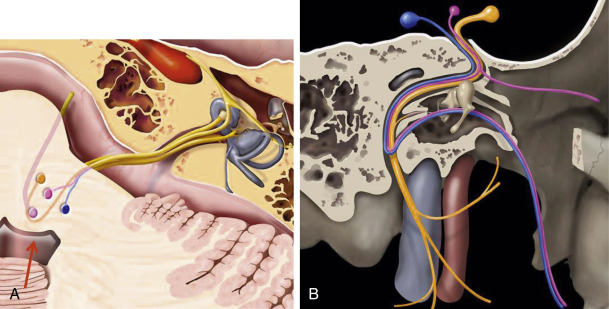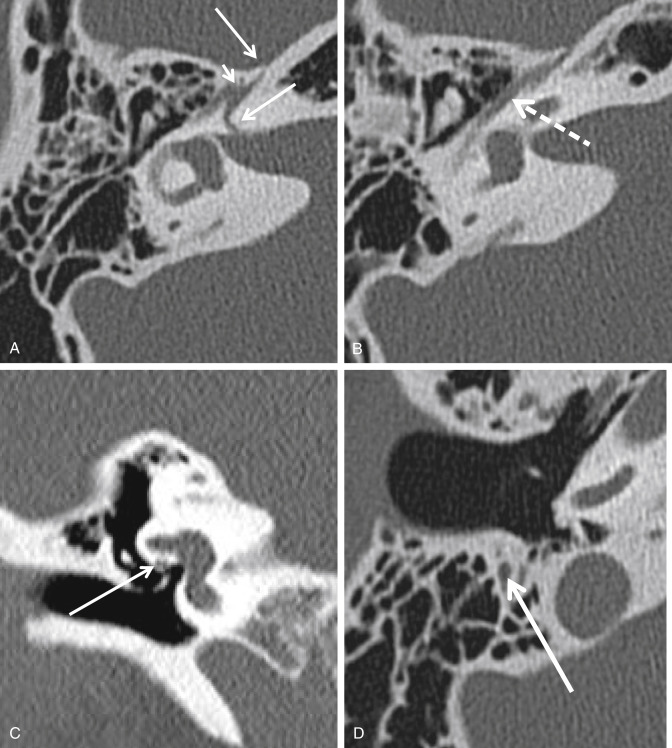Physical Address
304 North Cardinal St.
Dorchester Center, MA 02124
The facial nerve comprises motor, sensory, and parasympathetic fibers. The dominant motor component comprises 70% of the total axons. The sensory component makes up much of the remaining portion of the nerve and includes the nervus intermedius (nerve of Wrisberg). The motor division supplies somatic motor fibers to the muscles of the face, scalp, and auricle; the buccinators; the platysma; the stapedius; the stylohyoideus; and the posterior belly of the digastric. The motor division also contains sympathetic motor fibers, which constitute the vasodilator nerves of the submandibular and sublingual glands, conveyed through the chorda tympani nerve. The nerve of Wrisberg contains lacrimal secretomotor parasympathetic fibers and sensory fibers carrying input from the external auditory canal, the nasopharynx, and palate and taste sensation from the anterior two-thirds of the tongue and oral cavity. The facial nerve also has many clinically relevant communications with other cranial and cervical spinal nerves.
The supranuclear contribution from the motor cortex ( Fig. 9.1 ) originates from pyramidal neurons in the lower third of the precentral gyrus. The cortical projection fibers pass within the posterior genu of the internal capsule and descend in the pontine pyramidal tracts. The fibers for the lower facial muscles completely decussate to the contralateral facial nucleus. However, some cortical projection fibers for the upper face project to the ipsilateral as well as the contralateral facial nuclei. This explains why supranuclear lesions spare the motor functions of the upper face.

The motor nucleus of the facial nerve is located within the pontine tegmentum, just superior to the nucleus ambiguus, posterior to the superior olivary nucleus, and medial to the spinal trigeminal nucleus. The fibers course posteromedially and loop (the internal genu) around the medial aspect of the abducens nucleus to form the facial colliculus, a shallow bulge in the floor of the fourth ventricle, easily identified on axial MR images. This close anatomic relationship explains how both the facial and abducens nerves may be simultaneously affected by disease processes. The motor fibers exit the lateral border of the pons in the cerebellopontine angle cistern, where they lie medial to cranial nerve (CN) VIII ( Fig. 9.2 ).

The nerve of Wrisberg exits the pons between the motor root and CN VIII and courses parallel to the motor root, to the internal auditory canal. It also carries somatosensory fibers (from the trigeminal nucleus, having received them from the posterior auricular nerve) and special sensory taste fibers, received from the chorda tympani from the anterior tongue and oral cavity, to the nucleus tractus solitarius in the medulla.
The parasympathetic secretomotor component comprises fibers to the lacrimal and submandibular glands that originate in the superior salivatory nucleus. At the geniculate ganglion, the fibers to the lacrimal gland do not synapse but leave via the greater superficial petrosal nerve. They then join the deep petrosal nerve (comprising sympathetic nerve fibers) to form the vidian nerve (of the pterygoid canal) and synapse in the pterygopalatine ganglion. Postganglionic fibers reach the lacrimal gland via the zygomatic branch of the maxillary nerve (V2), which communicates with the lacrimal nerve (branch of the V1).
The preganglionic fibers for the submandibular and sublingual glands continue along the facial nerve, passing through the geniculate ganglion, and exit at the mastoid segment within the chorda tympani. The chorda tympani travels medial to the handle of malleus in the tympanic cavity and enters the infratemporal fossa through the petrotympanic/glaserian fissure, where it joins the lingual nerve (CN V3). The fibers synapse within the submandibular ganglion, innervating the submandibular and sublingual salivary glands.
The facial nerve may be conveniently divided into cisternal, intracanalicular, labyrinthine, tympanic, mastoid, and extracranial segments ( Fig. 9.3 ). The facial nerve exits from the pontomedullary sulcus at the root exit point. The nerve remains adherent to the undersurface of the pons for 8–10 mm, through the attached segment. The nerve then detaches from the pons at the root detachment point. The transition zone extends for approximately 2 mm, followed by the cisternal segment, which extends anterolaterally to the porus acusticus. The cisternal segment is typically 24 mm in length.

The nerve of Wrisberg exits between the motor root and the vestibulocochlear nerve. The nerve joins the motor root as it exits the brainstem or at the porus acusticus and becomes a common trunk, the nervi facialis. The intracanalicular segment travels within the anterior and superior quadrants of the internal auditory canal (IAC) for approximately 8 mm.
Within the lateral IAC, the nerve is separated from the cochlear nerve inferiorly by a horizontal partition of dura and bone, the transverse or falciform crest. A vertical dural and osseous crest known as Bill bar separates the facial nerve from the superior vestibular nerve, which lies posteriorly ( Fig. 9.3 ).
The facial/fallopian canal consists of three segments: labyrinthine, tympanic, and mastoid, extending from Bill bar to the stylomastoid foramen ( Fig. 9.3 ). The labyrinthine segment is the narrowest and shortest segment within the facial canal, 3–5 mm in length. It extends from the anterosuperior fundus to the geniculate ganglion. It passes between the ampulla of the superior semicircular canal and the cochlea to travel forward and downward. Exiting anteriorly from the geniculate ganglion is the first branch of CN VII, the greater superficial petrosal nerve (GSPN). At the geniculate ganglion, the nerve makes a sharp 75 degree turn posteriorly (anterior or first genu). This marks the beginning of the tympanic segment. The tympanic segment ( Fig. 9.3 ) is 10 mm in length. The nerve traverses the medial wall of the tympanic cavity superolateral to the oval window and inferior to the lateral semicircular canal. It then enters the facial recess, medial to the pyramidal eminence, and then turns inferiorly 95–125 degrees (posterior or second genu) to become the mastoid segment. The mastoid segment courses posteromedial to the external auditory canal and lateral to the inferior aspect of the tympanic annulus, extending for 13 mm in adults. The mastoid segment gives rise to the nerve to the stapedius and the chorda tympani.
The extracranial facial nerve exits the temporal bone at the stylomastoid foramen, situated between the styloid process anteriorly and the mastoid process posteriorly. The nerve immediately enters the substance of the parotid gland, after which it divides into two terminal branches: the upper temporofacial branch and the lower cervicofacial branch. In the parotid gland, these nerves further divide into temporal, zygomatic, buccal, marginal mandibular, and cervical branches.
The peripheral nerve is composed of three layers, the endoneurium, the perineurium, and the epineurium. The intracranial and intracanalicular segments of the nerve lack the perineurium and epineurium, making them more susceptible to injury.
Become a Clinical Tree membership for Full access and enjoy Unlimited articles
If you are a member. Log in here